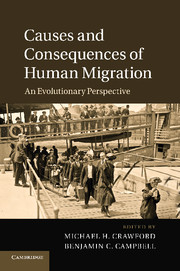Book contents
- Frontmatter
- Contents
- Contributors
- Preface
- 1 Perspectives on human migration: introduction
- Section 1 Theory
- Section 2 Geography and migration
- 8 Population structure and migration in Africa: correlations between archaeological, linguistic, and genetic data
- 9 Human migrations in North Africa
- 10 Identity, voice, community: new African immigrants to Kansas
- 11 The African colonial migration into Mexico: history and biological consequences
- 12 Demic expansion or cultural diffusion: migration and Basque origins
- 13 Consequences of migration among the Roma: immunoglobulin markers as a tool in investigating population relationships
- 14 Migration, assimilation, and admixture: genes of a Scot?
- 15 Mennonite migrations: genetic and demographic consequences
- 16 Human migratory history: through the looking-glass of genetic geography of Mycobacterium tuberculosis
- 17 Peopling the Tibetan plateau: migrants, genes, and genetic adaptations
- 18 Migration, globalization, instability, and Chinese in Peru
- 19 The great blue highway: human migration in the Pacific
- 20 Migration of pre-Hispanic and contemporary human Mexican populations
- 21 A review of the Tupi expansion in the Amazon
- 22 Molecular consequences of migration and urbanization in Peruvian Amazonia
- 23 Migration in Afro-Brazilian rural communities: crossing historical, demographic, and genetic data
- 24 Indentured migration, gene flow, and the formation of the Indo-Costa Rican population
- 25 Causes and consequences of migration to the Caribbean Islands and Central America: an evolutionary success story
- Section 3 Overview
- Index
- References
17 - Peopling the Tibetan plateau: migrants, genes, and genetic adaptations
Published online by Cambridge University Press: 05 December 2012
- Frontmatter
- Contents
- Contributors
- Preface
- 1 Perspectives on human migration: introduction
- Section 1 Theory
- Section 2 Geography and migration
- 8 Population structure and migration in Africa: correlations between archaeological, linguistic, and genetic data
- 9 Human migrations in North Africa
- 10 Identity, voice, community: new African immigrants to Kansas
- 11 The African colonial migration into Mexico: history and biological consequences
- 12 Demic expansion or cultural diffusion: migration and Basque origins
- 13 Consequences of migration among the Roma: immunoglobulin markers as a tool in investigating population relationships
- 14 Migration, assimilation, and admixture: genes of a Scot?
- 15 Mennonite migrations: genetic and demographic consequences
- 16 Human migratory history: through the looking-glass of genetic geography of Mycobacterium tuberculosis
- 17 Peopling the Tibetan plateau: migrants, genes, and genetic adaptations
- 18 Migration, globalization, instability, and Chinese in Peru
- 19 The great blue highway: human migration in the Pacific
- 20 Migration of pre-Hispanic and contemporary human Mexican populations
- 21 A review of the Tupi expansion in the Amazon
- 22 Molecular consequences of migration and urbanization in Peruvian Amazonia
- 23 Migration in Afro-Brazilian rural communities: crossing historical, demographic, and genetic data
- 24 Indentured migration, gene flow, and the formation of the Indo-Costa Rican population
- 25 Causes and consequences of migration to the Caribbean Islands and Central America: an evolutionary success story
- Section 3 Overview
- Index
- References
Summary
Introduction
The Tibetan plateau offers an interesting case study of human migration and subsequent adaptation, both cultural and biological, to a challenging environment. The Tibetan plateau, the highest in the world, presented to any early migrant two distinct challenges: the short- and long-term physiological effects of life at high elevation and the constraints of a relatively resource-poor and patchy environment. Moreover, there are relatively few easy routes onto the plateau – most have passes in excess of 5000 m, are blocked by snowfall for at least part of the year, or are associated with cold periglacial environments in even the most benign of times (Figure 17.1). Taken together, these are formidable obstacles, and one often hears the following question when describing the early prehistory of the plateau: “Why bother?” Yet at some point, most probably at multiple points in time, people did bother to move onto the plateau, and once established with permanence, created complex polities that vied for political power in the ancient world.
In this chapter, I will explore the following basic questions. What are the primary constraints on human biology at high elevation? What does archaeology say about the timing of migrations, their sources, and their frequency? What do data from the analysis of both ancient and modern DNA contribute to this discussion? I will then review what is known of the genetics of adaptation to high elevation in native Tibetans and conclude with an examination of the consonance (or lack thereof) of the archaeological, biological, and genetic data and their implications for furthering our understanding of human migration to the plateau. Because of the relative scarcity of archaeological and genetic data, I will necessarily approach these questions at a macro level, and focus upon broad regional and extra-regional processes that reflect the movement of people from the surrounding lowlands to the plateau. Snow (2010:10) describes such movement as “peopling events.” However, there may well have been hundreds, perhaps thousands, of dispersals or movements of individuals or families onto the plateau throughout prehistory. Many, if not most, of these likely left no presently observable traces in either the archaeological record or the genetic profile of modern peoples living on the plateau.
- Type
- Chapter
- Information
- Causes and Consequences of Human MigrationAn Evolutionary Perspective, pp. 342 - 372Publisher: Cambridge University PressPrint publication year: 2012
References
- 2
- Cited by



